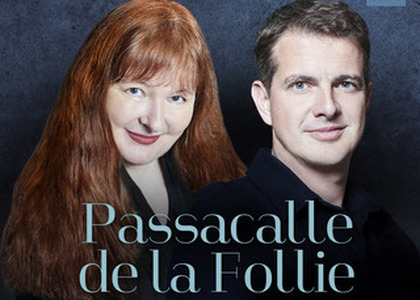Disk of 2023 > [Archived] Classic

Countertenor Philippe Jaroussky and L’Arpegiatta Ensemble, conducted by Christina Pluhar – ”Passacale de la Follie” – CD Review, April 7th, 2023
Countertenor Philippe Jaroussky and L'Arpegiatta Ensembre, conducted by Christina Pluhar - "Passacale de la Follie" - CD Review, April 7th, 2023
A new album by Philippe Jaroussky, accompanied by L'Arpegiatta Ensemble, conducted by Christina Pluhar is an event, we hope, not only for the lovers of old music. After unforgettable albums, which we cherish and listent to all the time - "Monteverdi - Teatro d'Amore", "Via Crucis", "Music for a While - Improvisations on Purcell", we are now offered a new theme - Arias for the French aristocracy of the18th century, under the name "Passacalle de la Follie", launched under Erato logo on February 17th. There are many years since Christina Pluhar, her musical group and countertenor Philippe Jaroussky started collaborating. It is the kind of experience that speaks for itself, supplied by the passion for performing this kind ofrepertoitre, which occupies its well-deserved place though the pages of the music history, essential for theEuropean civilization. It is also supplied by the science of being able to adapt, in a pleasant andapproachable manner to these old sheets and this is entirely Christina Pluhar's merit.
I want to add here the special vocal part, and here I'm reffering to Philippe Jaroussky, who is so refined incolors, expression, swiftness and bravery when confronted with an unknown repertoire. I quote from thepresentation of the album: "There are pages of refined expression which express love, regret, but there arealso spiritual reflections". The title "Passacalle de la Follie" is inspired by an Arie -"Yo soy lalocura", written on a Spanish text by Henri Le Bailly, a court musician.
Christina Pluhar is a theorbo player and director of the "L'Arpegiatta" Ensemble, founded in theyear 2000and she is assuming the concept and arrangement of this French Arie fromthe 18th century.- a celebration of the mind and soul, an homage to love, paid with a subtle art encountered throughout that era's saloons, in a restless century, dominated by political assassinations.Louis XIII inherited the throne at 9 years old, after a period of regency under his mother, Marie de'Medici-a bloody era, but with keycharacters that loved the art. As such, in France, a number of authors who compose this kind of Arie were highly valued. The term first appeared in a collection signed by Adrien Le Roy in 1571 and remains inthe public eye of the French aristocracy until the early years of Louis XIV's reign - who was passioned about elevated forms, such as the court ballet, comédie-ballet and later, lyrical tragedies.
But coming back at these aristocracy arias, the best known composers are Pierre Guédron, Antoine Boësset, Étienne Moulinie and Michel Lambert. We find them in this album with one ormore Arie, along with other names and several instrumental pages signed by Robert de Visee and Marin Marais, certainly an option meant to offer some kind of diversity for the musical discourse. The charm is immeasurable and listening to them is extremely pleasant. I do not remember the outstanding qualities of the interpreters - but we know them well, we admired themin the lastedition of the International Festival George Enescu (we hope to have this opportunity again).Until then, we divert ourselves with these new discographic releases.
Translated by Georgiana Morozii,
University of Bucharest, Faculty of Foreign Languages and Literatures, MTTLC, year II
Corrected by Silvia Petrescu














